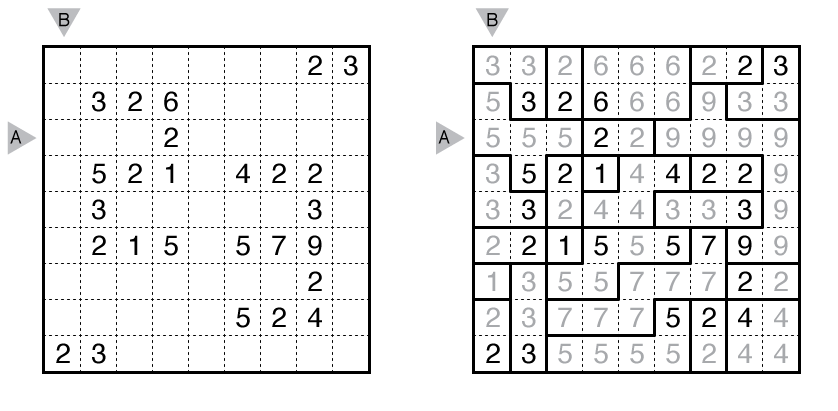Fillomino Rules and Info

Rules: Divide the grid along the dotted lines into regions called polyominoes so that no two polyominoes with the same area share an edge. Inside some cells are numbers; each number must represent the area of the polyomino it belongs to. A polyomino may contain zero, one, or more of the given numbers. (It is possible for a “hidden” polyomino — a polyomino without any of the given numbers — to contain a value that is not present in the starting grid such as a 6 in a puzzle with only 1-5 clues.)
Answer String: For each cell in the marked rows/columns, enter the area of the polyomino it belongs to. Start with the row/column marked “A”, followed by a comma, followed by the row/column marked “B”. Rows are entered in left-to-right order and columns in top-to-bottom order. This example has the key “555229999,355332122”. Note: if you encounter a double-digit number in one of our puzzles, please look at the puzzle’s answer string section to know if you should enter one or both digits. Our current puzzles use just the units digit (e.g., 10 is entered as 0) but some of our earlier posts required both.
(Brief) History of Fillomino: Fillomino was first published in 1994 by Nikoli in quarterly communication 47; the original author of the style was すらんた (Suranta), who may have been inspired by an earlier style “Firumatto” which involved packing 1 x n rectangles from size 1-4 with similar no touching rules.
History of this example: This puzzle, written by Thomas Snyder, was one of the Map Puzzles for BANG 23, a puzzle hunt held in the San Francisco Bay area.
Sources for Fillomino Puzzles: Follow this link for classic Fillomino puzzles on this website and this link for variations on Fillomino puzzles. If you are new to this puzzle type, here are our easiest Fillomino puzzles to get started on. More Fillomino puzzles can be found in Starter Pack 1: Fillomino, The Art of Puzzles, in Fill o’ Fillomino and Fill o’ Fillomino 2 by Grant Fikes, and in our beginner-friendly books Logic Puzzles 101 and Starter Pack 1: Fillomino.
Design rules for contributors: A Grandmaster Fillomino will have a unique solution that can be reached by logic alone. Generally, a Grandmaster Fillomino will have symmetric clues or an interesting visual theme in the absence of symmetry. Sizes from 8×8 and above are recommended (maximum aspect ratio of 2:1 if rectangular).

Firumatto has an additional rule: A grid dot must not be shared by the corners of four rectangles. This rule originates from the Tatami pattern (hence onomatopoeic “matto” = “mat”). See aleo http://en.wikipedia.org/wiki/Tatami
Is it ever possible for a polyomino to fully enclose another one? For example if you have an 8-omino that goes around a monomino in the center of a 3×3 square?
Yes, a polyomino can surround any number of other polyominoes.